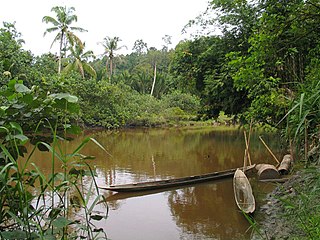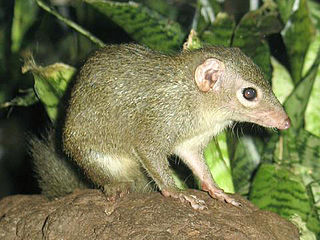
The treeshrews are small mammals native to the tropical forests of South and Southeast Asia. They make up the entire order Scandentia, which split into two families: the Tupaiidae, and the Ptilocercidae.

The pig-tailed langur, monotypic in genus Simias, is a large Old World monkey, endemic to several small islands off the coast of Sumatra in Indonesia. Its face is black, its fur is black-brown and it has a relatively short tail. It is a diurnal species, feeding in the rainforest canopy on leaves, and to a lesser extent, fruit and berries. Little is known of its natural history, but it is heavily hunted, its populations have been declining rapidly and the International Union for Conservation of Nature has assessed its conservation status as being "critically endangered". It has been included on a list of the World's 25 Most Endangered Primates.

The Mentawai Islands rain forests is a tropical moist broadleaf forest ecoregion in Indonesia. It covers the Mentawai Islands, an archipelago in the Indian Ocean off the west coast of Sumatra. The islands have been separated from Sumatra since the mid-Pleistocene period, and their geographic isolation allowed the evolution of several endemic species, including 17 endemic mammals.

The Pagai Island macaque, also known as the Pagai macaque or Bokkoi, is an Old World monkey endemic to the Mentawai Islands off the west coast of Sumatra. It is listed as critically endangered on the IUCN Red List due to its ever-shrinking habitat. Macaca pagensis formerly included the overall darker Siberut macaque as a subspecies, but this arrangement is polyphyletic, leading to the two being classified as separate species. Both were formerly considered subspecies of the southern pig-tailed macaque.

The common treeshrew is a small mammal in the treeshrew family Tupaiidae, and is native to Thailand, Malaysia, and Indonesia. It has been listed as Least Concern by IUCN as it remains common and displays some adaptability to ongoing habitat loss.
The Mentawai Archipelago rat is a species of rodent in the family Muridae. It is found only in the Mentawai Islands of Indonesia, on the islands of Siberut, Sipora, Pagai Utara, and Pagai Selatan.

The Nicobar treeshrew is a treeshrew species within the Tupaiidae. It is endemic to the Nicobar Islands where it inhabits the islands' rain forests. It is threatened by habitat loss.

The Palawan treeshrew is a treeshrew species endemic to the Palawan Island, Philippines, where it occurs from sea level to an elevation of 1,400 m (4,600 ft). The population is considered steady. Formerly, it was considered a subspecies of the common treeshrew.

The ruddy treeshrew is a treeshrew species in the family Tupaiidae. It is endemic to Borneo, the Natuna Islands and the Anambas Islands.

The large treeshrew is a treeshrew species within the Tupaiidae. It is native to Sumatra and adjacent small islands, as well as in the lowlands and hills of Borneo.

The Mentawai langur is a species of primate in the family Cercopithecidae. It is endemic to the Mentawai Islands in Indonesia. Its natural habitat is subtropical or tropical dry forests. The Siberut langur was formerly considered a subspecies of the Mentawai langur.

The Mindanao treeshrew, also called the Philippine tree shrew, is a species of treeshrew endemic to the Mindanao region in the Philippines. It was formerly considered the only member of the genus Urogale, but that genus was merged into Tupaia when the species was found to nest within the latter genus in a molecular phylogeny. The scientific name commemorates British colonial administrator and zoological collector Alfred Hart Everett.

Tupaia is a treeshrew genus in the family Tupaiidae that was first described by Thomas Stamford Raffles in 1821. The name of this genus derives from the Malay word tupai meaning squirrel or small animal resembling a squirrel.

Tupaiidae is one of two families of treeshrews, the other family being Ptilocercidae. The family contains three living genera and 19 living species. The family name derives from tupai, the Malay word for treeshrew and also for squirrel which tupaiids superficially resemble. The former genus Urogale was disbanded in 2011 when the Mindanao treeshrew was moved to Tupaia based on a molecular phylogeny.
The Bangka Island treeshrew, also known as the Bangkan treeshrew, is a treeshrew species within the Tupaiidae. It was previously listed as a junior synonym to Tupaia glis, but was raised up to species status in 2013. It is only found on Bangka Island, which is off the coast of Sumatra.
The Sumatran treeshrew is a treeshrew species within the Tupaiidae family. It was previously listed as a subspecies of Tupaia glis for one hundred years, but was raised up to species status in 2013. It is found on the islands of Sumatra and Tanahbala in Indonesia. It is the type species for the Tupaia genus.
The Javan treeshrew or large Javan treeshrew is a treeshrew species within the Tupaiidae family. It was originally described as a subspecies of Tupaia ferruginea and later listed as a junior synonym of Tupaia glis, but was raised up to species status in 2013. It is found on the island of Java in Indonesia.














